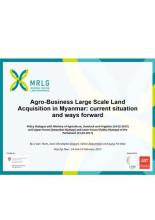Land Library
Bienvenue dans la bibliothèque du Land Portal. Explorez notre vaste collection de ressources en libre accès (plus de 74 000), comprenant des rapports, des articles scientifiques, des articles de recherche, des publications évaluées par des pairs, des documents juridiques, des vidéos et bien plus encore.
/ library resources
Showing items 1 through 9 of 22.The Mekong Region Land Governance (MRLG) project, MLIKE (Mekong Land Information and Knowledge Exchange), and the Land Portal co-facilitated an online dialogue on “Responsible Large Scale Agricultural Investments in the Mekong Region” on 09-27 October 2017.
Rubber prices in northern Laos have fallen significantly over the last few years, eroding much of the initial enthusiasm of both farmers and government officials about rubber providing a way out of poverty for poor upland farmers.
This presentation summarizes an on-going research in Myanmar, carried out by renowned agricultural specialist U San Thein and a team of experts, with the support of MRLG.
In Cambodia, the majority of the population is still composed of smallholder family farmers. 54% of the total labour force is employed in agriculture. They have access to 3.6 million ha of land, representing 19% of the country’s total land.
This conference paper examines how the ideology and programmatic set of policies coined in the term ‘neoliberal modernization’ applies to agriculture and practices in the Mekong region.
O texto aborda a dinâmica dos conflitos fundiários no Estado do Amapá. O trabalho resgata a gênese desse processo, apresentado pela política e pela mídia como uma relação pacífica no campo.
En este trabajo proponemos una mirada comparativa de la expansión territorial de las provincias argentinas de Buenos Aires y Santiago del Estero entre las décadas de 1850 y 1890.
O presente texto trata de aspectos da história agrária do antigo município de Soledade, localizado no norte do Rio Grande do Sul, Brasil. Interessa-nos conhecer faces da realidade local a partir da aplicação da Lei de Terras de 1850 e destacar algumas de suas conseqüências econômicas e sociais.







